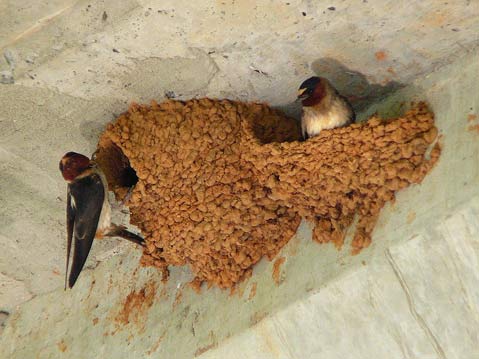Living with Swallows
Unique Nests, Unique Neighbors

Crafting their own mud-based additions to our houses, swallows often live very closely with people. Although to some these unique neighbors may seem only to be a nuisance, swallows and humans affect one another in many ways both positive and negative.
The first birds evolved from dinosaurs around 150 million years ago, in the Late Jurassic era. The birds diversified for millions of years and then, around 50 million years ago, the predecessors of the swallow family (family Hirundinidae) evolutionarily diverged from their relatives.

Swallows today often astonish onlookers both with their swift, aerial acrobatics, which they perform to catch flying insects, and the mud nests that they frequently attach to buildings. It’s thought that they originated in Africa, where a drier climate may have promoted making nests from mud—a behavior also seen in flamingos, for example. It was clearly a successful strategy, as there are now more than 75 swallow species worldwide, living or migrating through nearly everywhere except in the most extreme environments.
While seven different species of swallows have been spotted in Santa Barbara County at some point, two of the more common species have developed an intimate relationship with humans, whether their presence is welcomed or not.
The cliff swallow (Petrochelidon pyrrhonota) and the barn swallow (Hirundo rustica) both create distinctive mud nests under the eaves of buildings. (However, this clearly could not always have been the case, as human buildings haven’t been around for very long on evolutionary timescales). Because they need mud to build their nests and swarming, flying insects to eat, the swallows prefer nesting areas with bodies of water nearby. And that may give you an idea for cutting down on those annoying mosquitoes.
Barn Swallows v. Cliff Swallows: Both cliff and barn swallows sport the same general hues, having an overall blue, slender body along with a rust-colored spot on their face and a white belly, but the two can be told apart by other distinctive features.
The most identifiable difference is that the barn swallow has a deeply forked tail, while the cliff swallow has a square tail. Additionally, the cliff swallow has a pale orange-brown band on the back of its neck and forehead, forming a blue “crown” on the head. The other most notable difference is that cliff swallows create large nesting colonies, made famous by the colonies of San Juan Capistrano, whereas barn swallows have smaller nesting colonies in more rural areas.
Both barn and cliff swallows travel impressive distances each year. Cliff swallows generally breed in North America or Mexico, and migrate to South America for the winter. While breeding, they’re most numerous in the mountainous areas of western North America, specifically near open areas with water and cliffs or human-made structures. By late February or early March, cliff swallows arrive in Southern California, and are found in Northern California a few weeks later. They time their migration so that flying insects, which require warm weather, are available to eat as they progress northward. During the fall, cliff swallows fly south, to winter throughout South America, sometimes flying as far as Tierra del Fuego or the Galapagos Islands.
Barn swallows, known commonly in Europe as simply “swallows,” are the most widespread species of swallow, breeding by farmlands or human habitations in Asia, Europe, and North America. In Europe, barn swallows typically arrive in the springtime to breed and nest, then in the fall start heading south to Africa to winter. In the Americas, like cliff swallows, barn swallows migrate south to winter throughout South America.
Life and Love in the Colony:: Cliff swallows arrive at old nesting colonies in waves, often returning to their previous colony sites. However, the nests are not necessarily taken by the birds that originally made them; the birds frequently choose a new nest. The intact, old nests are highly prized and quickly claimed first, while damaged nests are next. Any old nest remnants, even a bit of mud, can entice a swallow to rebuild an entire nest in a previously used spot, and nests that fall will be persistently rebuilt.
The nest building process starts when a male cliff swallow finds and claims a nesting spot, chasing away other interested birds. But, if a female is persistent for several days, he may accept her as his mate. The two copulate and begin to build a new home together. The male starts by creating a narrow crescent of mud, which turns into a ledge, off of which the pair can build the rest of the nest.
As with cliff swallows, a male barn swallow also picks the nesting site, but because barn swallows are almost always monogamous, they are often paired before arriving. Consequently, the male barn swallow acts to entice a female to a nesting site, performing a little dance accompanied by a song, and may even show her several nesting sites before she is satisfied. Once the site is decided upon, they mate near it.
For both cliff and barn swallows, it takes one or two weeks for the couple to build a new nest, though only a few days to repair a damaged one.
Cliff swallows are famous for their gregarious nature: They form colonies that usually have a few hundred nests, but that may have as many as 2,000 or 3,000. Nests are fiercely guarded, sometimes to the death, and frequent disputes break out. Females attempt to lay eggs in, or even carry them to, other swallows’ nests, while males attempt to breed with females that aren’t their mates.
Barn swallows are not as social, and usually have only single pairs nesting in an area, or groups of up to 30 pairs. However, their lives are still far from drama-free. Although barn swallows are monogamous, broadly speaking, some males may mate with multiple females in the colony. Unpaired males may kill hatchlings and then try and mate with the now-offspring-less female.
Different Nests: Not only are cliff and barn swallow colonies easy to tell apart due to the great difference in nest numbers, but the individual nests appear different as well.
Cliff swallows create pear-shaped nests attached to a vertical wall and covered by a horizontal overhang or mud roof, with a tunnel traveling downward to the interior of the nest.
Barn swallows create deep, bowl-shaped nests, which may contain coarser material, such as horse hair, grass stems, and occasionally seaweed, lined with feathers.
Cliff swallow nests are made of about 1,000 to 1,400 mud pellets (which are mostly sand, clay, and silt), while the slightly smaller barn swallow nests may have about 1,000 mud pellets. Each pellet represents one trip to a pond, ditch, or puddle up to half a mile away.
And if that doesn’t sound like enough work, cliff swallows may build two to three nests per season, some of which may not be used at all!
Although these birds may seem to be big planners, cliff swallows actually start laying eggs before the nest is complete. In Southern California, usually the first eggs arrive in March when the floor, walls, and part of the tunnel are established, but the nest is still very much under construction. Cliff swallows lay three to four eggs; Barn swallows have about four to five. Both species hatch after about two weeks’ incubation.
In large hunting flocks, cliff swallows search two to four miles from the nest for flying, swarming insects to feed the nestlings. Prolonged periods of rain can make it difficult for the parents to find insects, and consequently the baby birds may be abandoned. In a good year, however, the dull-colored fledglings start taking flight around May to June, but still remain near the nest and communicate with their families through a variety of calls. Cliff swallows normally have one brood annually, rarely two, while barn swallows have two broods, and sometimes a third.
By October, most swallows have left for their winter retreats. The average swallow lives only a brief span of years, with records of nine years for cliff swallow and nearly 16 years for barn swallow.
Along Comes Human: Humans and human-made structures have significantly changed the lifestyle of barn and cliff swallows. As their name implies, cliff swallows originally built their nests on cliff walls in canyons. Barn swallows built their nests in caves as well as cliff sides. When people started to build permanent structures, swallows became attracted to them for nesting. Today, cliff swallows will nest on the side of a variety of manmade structures, from buildings to bridges and overpasses. Barn swallows prefer these structures in more rural settings, nesting in farm buildings and stables near domestic animals, such as cows and pigs. The great number of structures created by people has significantly increased the number of nesting sites for these swallows, drastically increasing their numbers overall.
However, the interaction between these swallows and humans hasn’t been all positive. In the mid 1800s, the house sparrow (Passer domesticus) was introduced to North America and proceeded to do quite well, competing with native birds. House sparrows sometimes take over cliff swallow nests whether they’re empty or not; the tell-tale sign is grass and feathers sticking out of the nest’s entrance. Barn swallows had declines in the 1800s due to the house sparrow introduction, although most barn swallow populations have increased in the last century due to the creation of more human-made structures, buildings, and bodies of water.
The uniquely close relationship between swallows and human structures allows us to better watch and admire these birds up close, but sometimes they can cause a nuisance. Caution must be taken when attempting to remove the nests, as swallows are protected under the Migratory Bird Treaty Act of 1918, and, as a result, a permit from the U.S. Fish and Wildlife Service must be obtained to remove a nest occupied by the birds, their babies, or their eggs. Instead of tearing the nests down, it is recommended to (install devices to prevent nests from occurring, if there is any concern that they may, for example, pose a heath hazard by contaminating food. Ideally, we can find some way to coexist with these longtime neighbors even if they are a little messy; we haven’t been the best of neighbors either, as we too have created problems by, among other things, destroying nests and inviting over the pushy house sparrows.
For more on swallows, see Angela Turner’s Swallows and Martins, Charles R. Brown and Mary Bomberger Brown’s Coloniality in the Cliff Swallow, the Division of Agricultural Sciences University of California’s “Cliff Swallows: How to Live with Them,” David Winkler and Frederick Sheldont’s “Evolution of nest construction in swallows (Hirundinidae): A molecular phylogenetic perspective,” Washington Department of Fish and Wildlife’s “Living with Wildlife: Barn Swallows and Cliff Swallows,” Wikipedia’s article on Swallows, the Fish and Wildlife Service’s “Migratory Bird Treaty Act of 1918,” a memo clarifying the Act, and Independent article by Lisa Acho Remorenko on “Living in Harmony with Wildlife.”
Biology Bytes author Teisha Rowland is a science writer, blogger at All Things Stem Cell, and graduate student in molecular, cellular, and developmental biology at UCSB, where she studies stem cells. Send any ideas for future columns to her at science@independent.com.



